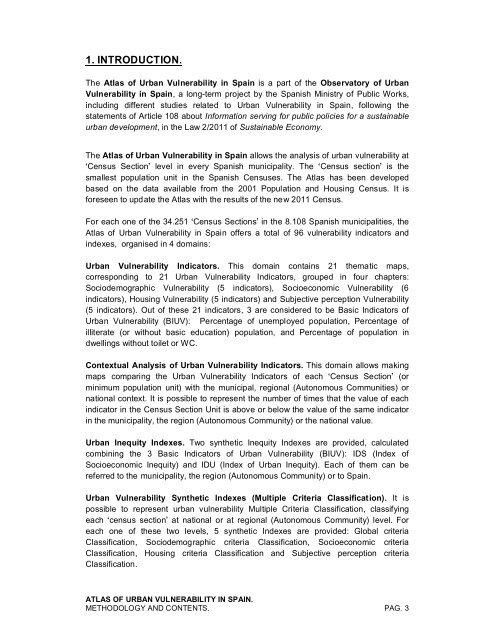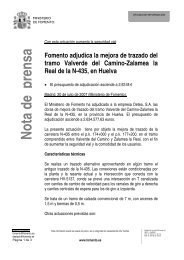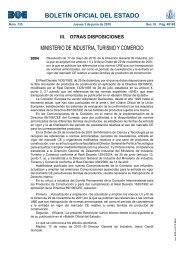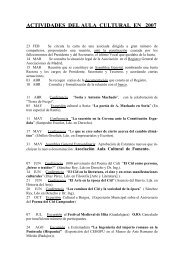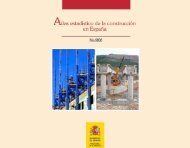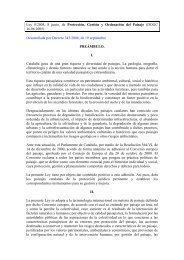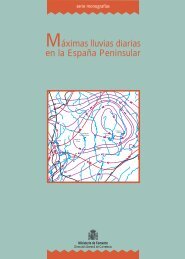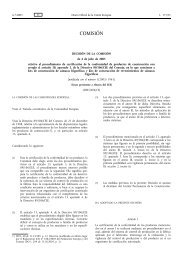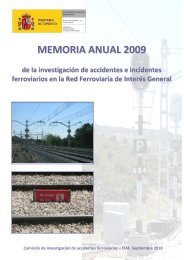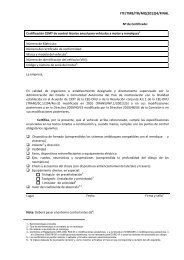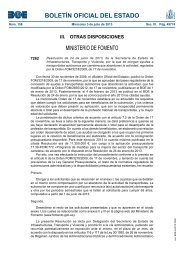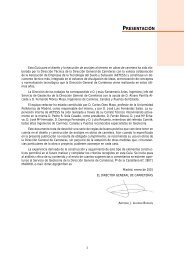atlas of urban vulnerability in spain: methodology and contents
atlas of urban vulnerability in spain: methodology and contents
atlas of urban vulnerability in spain: methodology and contents
You also want an ePaper? Increase the reach of your titles
YUMPU automatically turns print PDFs into web optimized ePapers that Google loves.
1. INTRODUCTION.<br />
The Atlas <strong>of</strong> Urban Vulnerability <strong>in</strong> Spa<strong>in</strong> is a part <strong>of</strong> the Observatory <strong>of</strong> Urban<br />
Vulnerability <strong>in</strong> Spa<strong>in</strong>, a long-term project by the Spanish M<strong>in</strong>istry <strong>of</strong> Public Works,<br />
<strong>in</strong>clud<strong>in</strong>g different studies related to Urban Vulnerability <strong>in</strong> Spa<strong>in</strong>, follow<strong>in</strong>g the<br />
statements <strong>of</strong> Article 108 about Information serv<strong>in</strong>g for public policies for a susta<strong>in</strong>able<br />
<strong>urban</strong> development, <strong>in</strong> the Law 2/2011 <strong>of</strong> Susta<strong>in</strong>able Economy.<br />
The Atlas <strong>of</strong> Urban Vulnerability <strong>in</strong> Spa<strong>in</strong> allows the analysis <strong>of</strong> <strong>urban</strong> <strong>vulnerability</strong> at<br />
Census Section level <strong>in</strong> every Spanish municipality. The Census section is the<br />
smallest population unit <strong>in</strong> the Spanish Censuses. The Atlas has been developed<br />
based on the data available from the 2001 Population <strong>and</strong> Hous<strong>in</strong>g Census. It is<br />
foreseen to update the Atlas with the results <strong>of</strong> the new 2011 Census.<br />
For each one <strong>of</strong> the 34.251 Census Sections <strong>in</strong> the 8.108 Spanish municipalities, the<br />
Atlas <strong>of</strong> Urban Vulnerability <strong>in</strong> Spa<strong>in</strong> <strong>of</strong>fers a total <strong>of</strong> 96 <strong>vulnerability</strong> <strong>in</strong>dicators <strong>and</strong><br />
<strong>in</strong>dexes, organised <strong>in</strong> 4 doma<strong>in</strong>s:<br />
Urban Vulnerability Indicators. This doma<strong>in</strong> conta<strong>in</strong>s 21 thematic maps,<br />
correspond<strong>in</strong>g to 21 Urban Vulnerability Indicators, grouped <strong>in</strong> four chapters:<br />
Sociodemographic Vulnerability (5 <strong>in</strong>dicators), Socioeconomic Vulnerability (6<br />
<strong>in</strong>dicators), Hous<strong>in</strong>g Vulnerability (5 <strong>in</strong>dicators) <strong>and</strong> Subjective perception Vulnerability<br />
(5 <strong>in</strong>dicators). Out <strong>of</strong> these 21 <strong>in</strong>dicators, 3 are considered to be Basic Indicators <strong>of</strong><br />
Urban Vulnerability (BIUV): Percentage <strong>of</strong> unemployed population, Percentage <strong>of</strong><br />
illiterate (or without basic education) population, <strong>and</strong> Percentage <strong>of</strong> population <strong>in</strong><br />
dwell<strong>in</strong>gs without toilet or WC.<br />
Contextual Analysis <strong>of</strong> Urban Vulnerability Indicators. This doma<strong>in</strong> allows mak<strong>in</strong>g<br />
maps compar<strong>in</strong>g the Urban Vulnerability Indicators <strong>of</strong> each Census Section (or<br />
m<strong>in</strong>imum population unit) with the municipal, regional (Autonomous Communities) or<br />
national context. It is possible to represent the number <strong>of</strong> times that the value <strong>of</strong> each<br />
<strong>in</strong>dicator <strong>in</strong> the Census Section Unit is above or below the value <strong>of</strong> the same <strong>in</strong>dicator<br />
<strong>in</strong> the municipality, the region (Autonomous Community) or the national value.<br />
Urban Inequity Indexes. Two synthetic Inequity Indexes are provided, calculated<br />
comb<strong>in</strong><strong>in</strong>g the 3 Basic Indicators <strong>of</strong> Urban Vulnerability (BIUV): IDS (Index <strong>of</strong><br />
Socioeconomic Inequity) <strong>and</strong> IDU (Index <strong>of</strong> Urban Inequity). Each <strong>of</strong> them can be<br />
referred to the municipality, the region (Autonomous Community) or to Spa<strong>in</strong>.<br />
Urban Vulnerability Synthetic Indexes (Multiple Criteria Classification). It is<br />
possible to represent <strong>urban</strong> <strong>vulnerability</strong> Multiple Criteria Classification, classify<strong>in</strong>g<br />
each census section at national or at regional (Autonomous Community) level. For<br />
each one <strong>of</strong> these two levels, 5 synthetic Indexes are provided: Global criteria<br />
Classification, Sociodemographic criteria Classification, Socioeconomic criteria<br />
Classification, Hous<strong>in</strong>g criteria Classification <strong>and</strong> Subjective perception criteria<br />
Classification.<br />
ATLAS OF URBAN VULNERABILITY IN SPAIN.<br />
METHODOLOGY AND CONTENTS. PAG. 3


